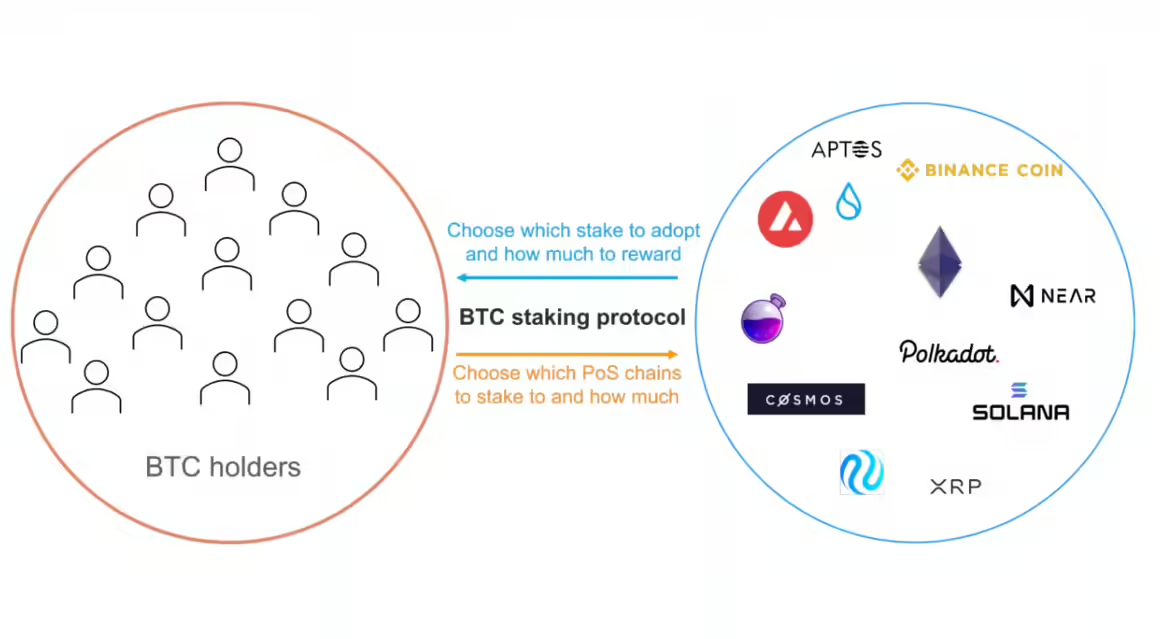TL;DR
- To ensure their security, PoS chains necessitate a significant amount of capital. On the other hand, Bitcoin, which operates on a Proof-of-Work mechanism, represents a largely inactive asset with a market value of approximately $600 billion.
- Bitcoin staking allows Bitcoin holders to stake their idle assets, enhancing the security of PoS chains and earning yield.
- The Bitcoin staking protocol enables trustless staking without the need to bridge Bitcoins to the PoS chain, providing full slashable security guarantees.
- The proposed system architecture scales to accommodate numerous stakers and PoS chains, with a Bitcoin-staked Babylon chain synchronizing between Bitcoin and the PoS chains.
How To Secure PoS Chains With Trustless Bitcoin Staking
Ok, let’s dive in👇
What is Bitcoin Staking?

Bitcoin staking refers to a new protocol that enables Bitcoin holders to earn yield while enhancing the security of Proof-of-Stake (PoS) chains. Detailed in a lite paper, this protocol outlines the key concepts, challenges, and benefits of Bitcoin staking.
A distinctive feature of this design is its ability to offer complete economic security without necessitating the bridging of bitcoins to other chains.
What Problem is Bitcoin Staking Solving?
Bitcoin staking is solving the problem of enabling Bitcoin holders to earn yield while increasing the security of PoS chains without the need to bridge their bitcoins to other chains.
Security challenges of PoS chains: New or smaller blockchains often struggle to attract the capital necessary to secure their chains. The larger the market capitalisation of the securing stake, the stronger the chain’s economic security. Bitcoin staking can bolster this security by bringing a significant amount of capital to PoS chains.
Underutilisation of Bitcoin assets: Bitcoin is now a $600 Billion asset and most of it is idle capital and undeployed because most yield-generating activities occur on PoS chains. Bitcoin staking could offer a solution by providing a safe way for Bitcoin holders to earn yield.
Centralisation of PoS assets: Many PoS assets are held by a relatively small number of early investors, founders, and team members, creating potential centralisation risks. Bitcoin’s highly decentralised ownership/token distribution could help mitigate this risk when its assets are staked on PoS chains.
Volatility of PoS assets: Bitcoin, being the largest and most established crypto asset, is less volatile than most PoS assets. This lower volatility can help stabilize the security of PoS chains, as security is directly tied to the market capitalisation of the staked asset.
Risks of Bitcoin Bridging: The protocol addresses the security and capacity issues of prevailing Bitcoin bridges by maintaining the Bitcoin stake distribution on the Bitcoin chain, which is immune to long-range attacks. This means that Bitcoin holders can trustlessly stake their bitcoins without bridging them to the PoS chain but yet provides the chain with full slashable security guarantees.
Additionally, the protocol supports fast stake unbonding to maximize the liquidity for Bitcoin holders.
By solving these problems, Bitcoin staking enables an important new use case for Bitcoin and takes a significant step towards integrating Bitcoin and the Proof-of-Stake economy.
The Team Behind Bitcoin Staking

The team behind the Bitcoin staking protocol is from Babylon Chain.
This project is developed by a team of consensus protocol researchers from Stanford University and experienced Layer 1 developers from around the world.
The team is led by David Tse, a professor at Stanford University and the founder of Babylon Chain. Tse is an information theorist and recipient of the Claude E. Shannon Award. He has played a pivotal role in the development of Babylon chain, a platform that aims to reuse the immense Bitcoin hash power to enhance the security of proof-of-stake chains.
Security Properties and Challenges of the Babylon Bitcoin Staking Protocol
The Babylon Bitcoin Staking Protocol incorporates several critical properties and addresses prominent challenges to maximize both the security and efficiency of Bitcoin staking.
Fully Slashable PoS Security: The protocol ensures that in the event of any safety violation, 1/3 of the Bitcoin stake is assured to be slashed. As long as 2/3 of the Bitcoin stake adheres honestly to the PoS protocol, the PoS chain maintains its liveliness. This system penalizes protocol violators and thus strengthens the integrity of the PoS chains.
Staker Security: Every Bitcoin staker is guaranteed to withdraw their funds, or unbond, as long as they follow the PoS protocol honestly. This provides individual security for each participant and encourages trust in the staking process.
Staker Liquidity: The process of unbonding staked bitcoins is designed to be both secure and swift without the need for social consensus. This property optimizes the staking experience, reducing unnecessary waiting periods, and bolstering confidence in the staking protocol.
Addressing Bridging Risks and Remote Staking Challenges: Despite these security properties, Bitcoin staking presents two major challenges: Bridging risks associated with transferring bitcoins to PoS chains and limitations in remote staking due to Bitcoin’s lack of smart contract support.
- For the bridging approach, while it can offer slashable security to the PoS chain, it fundamentally limits the security of the bridging solution itself. Existing Bitcoin bridges often trust a centralized custodian or a multisig bridge committee, thereby not achieving trustless staking.
- Remote staking, on the other hand, locks staked bitcoins in a contract on the Bitcoin chain and slashes the stake upon protocol violation on the PoS chain. However, because Bitcoin only supports a scripting language with limited expressiveness, implementing slashing becomes a technical challenge.
To counteract these challenges, the Babylon Bitcoin Staking Protocol employs the remote staking approach. It compensates for the lack of smart contracts by combining advanced cryptography, consensus protocol innovations, and optimized use of the Bitcoin scripting language. The outcome is a more secure and efficient staking protocol that offers trustless staking while maintaining full slashable PoS security.
What Could be the Main Use Case for Bitcoin Staking?
Bitcoin staking’s primary use case is expected to be rapid bootstrapping for Appchains, or application-specific blockchains.
This process is evident in the Cosmos ecosystem, where new chains borrow security from the established Cosmos Hub. When it becomes feasible to borrow security from Bitcoin, the most decentralized and valuable chain, it will significantly speed up the launch of various Appchains.
These can cater to unique user needs, ranging from decentralized finance to gaming platforms, while leveraging Bitcoin’s robust security and decentralization.
System Design

The core infrastructure of the Bitcoin staking protocol acts as a control plane between Bitcoin and the PoS chains. It is responsible for several key functionalities, including:
- Providing Bitcoin timestamping services to the PoS chains to enable synchronization with the Bitcoin network.
- Acting as a marketplace to match Bitcoin stakes and the PoS chains while tracking staking and validation information.
- Recording the finality signatures for the PoS chains.
On the other hand, validators of each PoS chain run the data plane of the architecture. They generate and validate blocks as per the normal consensus protocol and sign finality signatures on the finality gadget.
The control plane is implemented as a chain to ensure decentralization, security, resistance to censorship, and scalability. This design allows for efficient timestamp aggregation for any number of PoS chains.
This three-layer architecture enables the interaction between Bitcoin and the PoS chains, paving the way for network effects and potential interoperability. For instance, cross-PoS-chain transactions can be settled on the control plane based on the finality status of the two PoS chains.
Understanding the Key Components of Bitcoin Staking
1. Staking Contracts on Bitcoin
Since Bitcoin lacks a smart contract layer, staking contracts must be expressed using UTXO transactions written in Bitcoin script. A staking contract involves following steps:
- Staking Transaction: This is where a user, or staker, commits their Bitcoin. After committing their Bitcoin, the staker can spend their committed Bitcoin in two ways:
- Unbonding Transaction: After a certain period, known as a relative lock time, the staker can withdraw or ‘unbond’ their staked Bitcoin.
- Slashing Transaction: The staker can instantly send their committed Bitcoin to a locked or ‘burn’ address that no one can spend from.
- Unstaking Transaction: which can spend the output of the unbonding transaction after the relative timelock has expired
This is what a Bitcoin staker’s journey looks like:

- Alice initiates a staking contract by locking her Bitcoin on the Bitcoin chain in a self-custody vault.
- Alice starts validating for the PoS chain, signing blocks with her key.
Two outcomes can follow:
- Alice follows the protocol honestly. She ends her staking by issuing an unbonding transaction. After 3 days, her Bitcoin and PoS reward are returned.
- Alice violates the protocol by participating in a double-spend attack. Her private key is exposed, allowing anyone to burn her Bitcoin by issuing a slashing transaction.
2. Automated Slashing via Accountable Assertions and Finality Gadgets
Since Bitcoin doesn’t support smart contracts, safety violation evidence can’t be processed directly by Bitcoin. The Babylon Protocol addresses this by allowing the submission of evidence that leads directly to slashing.
This is achieved by combining accountable assertions from cryptography and finality gadgets from blockchain consensus, leading to an extractable one-time signature (EOTS).
The use of an EOTS finality gadget ensures that if there is a safety violation, the private keys of the violators will be leaked and can be used to execute the slashing transactions. This solution is modular and can be applied to all BFT consensus protocols without modifying the base protocols, making it PoS-chain-agnostic.
3. Fast Unbonding via Bitcoin Timestamping
Unbonding time in PoS chains can be lengthy due to the need for social consensus to combat long-range attacks. The Babylon Protocol leverages Bitcoin’s resilience to long-range attacks to facilitate fast unbonding.
However, an attacker can slow down the PoS chain, resulting in an outdated staker set used to validate a PoS block. To address this issue and enable fast unbonding, Bitcoin timestamping is used to tightly synchronize the PoS chain with the Bitcoin chain.
Slashing Risk in Bitcoin Staking
The slashing risk in Bitcoin staking represents a critical aspect that potential stakers must thoroughly understand. In an effort to ensure the integrity and security of the PoS chains, the Bitcoin staking protocol stipulates that in the event of a protocol violation, up to a third of the staked Bitcoin could be subject to slashing.
This essentially means that the staker stands to lose a significant portion of their staked Bitcoin if they don’t strictly adhere to the rules of the protocol. This risk serves as a deterrent against malicious activities or breaches, enforcing compliance and reinforcing the security of the PoS chains.
Therefore, potential Bitcoin stakers must be fully aware of the terms of the protocol and the potential risk of slashing before deciding to stake their Bitcoin.
Babylon’s Bitcoin Timestamping Protocol: Enhancing Cross-chain Security and Efficiency
Babylon’s has launched a testnet of Bitcoin (BTC) timestamping protocol, which anchors the events of other blockchains onto the Bitcoin network.
By doing this, these events receive Bitcoin timestamps analogous to Bitcoin transactions, essentially incorporating Bitcoin’s robust security as a timestamping server.

As of now, Babylon’s Bitcoin timestamping testnet has successfully integrated with 31 Inter-Blockchain Communication (IBC) enabled chains, demonstrating its capability in facilitating effective cross-chain interaction.
Conclusion
In conclusion, Bitcoin staking, as presented by the Babylon Chain team, seeks to address some of the critical challenges faced by PoS chains.
The protocol could enable Bitcoin holders to earn yield, bolstering the security of PoS chains without the need for Bitcoin bridging. By addressing underutilization of Bitcoin assets, centralization risks of PoS assets, volatility of PoS assets, and Bitcoin bridging risks, it is establishing a new way forward for the integration of Bitcoin into the PoS economy.
It’s essential to note, however, that the concept of staking—while rewarding—also carries risks. Particularly, in a situation of protocol violation, the design ensures that up to a third of the staked Bitcoin could be slashed. This serves to maintain the integrity and security of the system, but it also means that stakeholders need to be aware of the potential to lose a portion of their staked Bitcoin if they don’t adhere strictly to the protocol’s requirements.










